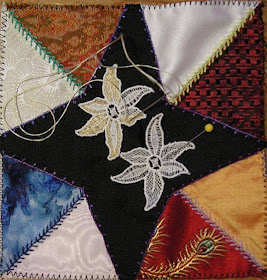As promised, the poppy!
Ann Cox's book has been a brilliant guide, although the font is a little small and I find her instructions a bit wordy. But I am sure that every single thing she says is important, so I squint and pay close attention.

This is a "medium" level flower, and it did take quite awhile, but it was fun, and worth it.
There was a lot of multi-needle action going on!

You gather the edge of the ribbon with a fine thread, and then bury the end of the ribbon (13mm, from
RiverSilks) with a large needle, being careful not to munch your gathering thread. It is all rather pickier work than I am used to.

The concept is this: you bury both ends of the ribbon, (knotting it off on the back with threaded needle #3), then you pull on the gathering thread, then you tack down the petal at the gathered base, catching the fine thread. This shot shows petal # 3's second end being buried.
I would never have thought of this in a million years.

Painting the ribbon after it is in place is not that hard...especially with a black background! ;-) You do have to be careful not to let the paint run, and I had my blow-dryer handy to zap my ribbon dry as soon as I was done putting the Dye-Na-Flow on it.
I decided not to give my poppy a black center because of that black background, and went with the pale green one that some Shirley poppies have.

This, too, is quite picky work, but there is a reason Ann Cox's flowers look so nice.
Can you see how this is gathered twice, first the circle of silk around the interfacing/stuffing core (oh yes, you don't just use stuffing, you provide a flat surface for the stuffing to rest on), and then around the perimeter? This gives a smooth and even surface for the center.

Ann shows you how to wrap the threads used for the pistols around a large needle so they will be of uniform length when you cut open the loops.

The stem was just some couched yarn, and the leaves some 4mm ribbon in a fly stitch.
It's sweet. I like it.
Here is a reminder of the quilt that inspired all this....

I wish I knew the name of the maker, or even the source of the photograph, but alas, I don't.
It is sublime, isn't it?
I had made some blocks this summer to go around the central section of wheel blocks, but have decided to scrap them. They are too loud and--alright, crass--for these dignified flower blocks. I don't wish to replicate this quilt exactly, but I'm going to have to try again with the outer ring of blocks.
But I still have 10 flower blocks to go....and that's only making 30 of them, not the 40 this quilt has.
For my next one, I plan on borrowing
a concept from Thelma Bradshaw. Her work is so amazing....

 It's a bittersweet feeling!
It's a bittersweet feeling! They look a lot like poinsettias to me. The way they are placed will make a nice contrast to the other blocks, most of which have their flowers centered in the middle.
They look a lot like poinsettias to me. The way they are placed will make a nice contrast to the other blocks, most of which have their flowers centered in the middle.














